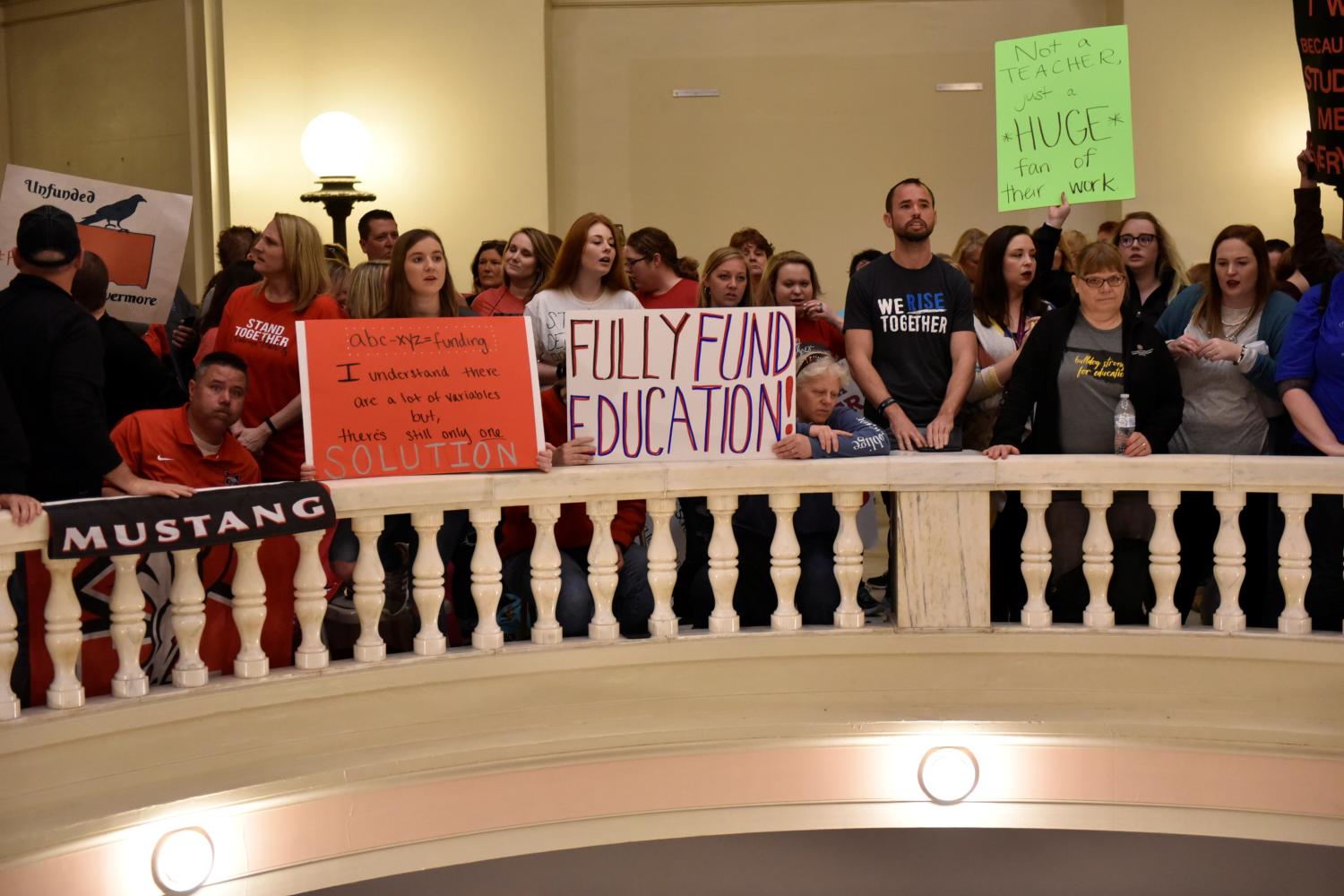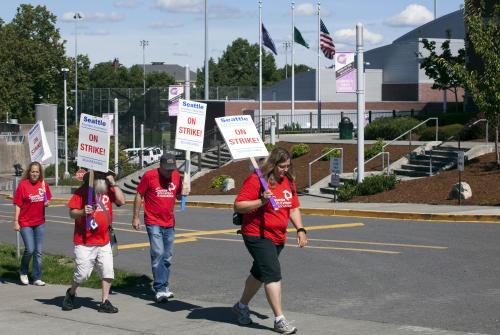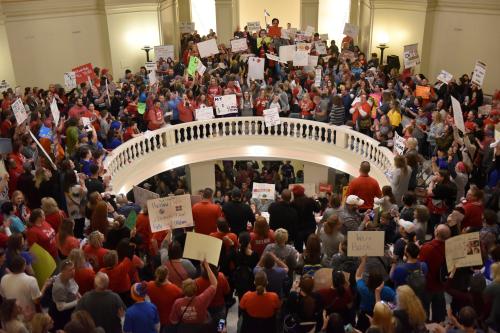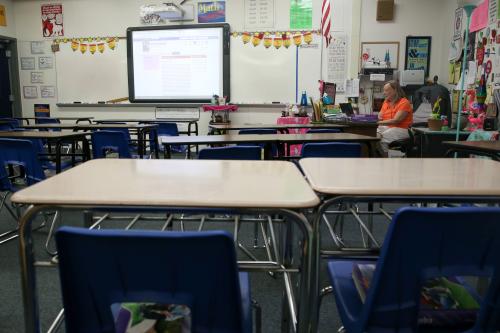Over the last six weeks, statewide teacher strikes have been making headlines across the country. What started as a dispute about health insurance premiums rising faster than teacher paychecks in West Virginia—where salaries were already among the lowest in the nation—concluded nine days later after state legislators conceded to educators’ demands for a 5 percent salary increase. The victory has emboldened teachers across the country to examine their own pay, and teachers in Arizona, Kentucky, and Oklahoma have organized protests to advocate for state-level action.
Teaching in K-12 public schools is not a particularly well-paying job. Teachers in the U.S. are paid about 30 percent less than other comparably educated workers in the economy, and this gap is larger than most other industrialized countries. Low salaries are certainly a contributing factor to the teacher strikes and protests that we are seeing, though they are simply the most visible of a number of factors contributing to these events. Let me describe a few of the less prominent factors that are also lurking under the surface.
Teachers feeling a pinch
Though relatively low pay has been a historical, well-known feature of the teaching profession, most of the public does not know that many teachers nationwide are feeling a pinch in their paychecks much more acutely in recent years.
Many states and districts, in an effort to cut costs in the wake of the Great Recession, cut back on education spending. The majority of states have still not returned to pre-recession funding levels. Interestingly, West Virginia is one of the states where education funding has slightly grown since the recession, but the other three states with recent teacher actions are among those with lower total per-pupil spending now than a decade ago. Arizona is the worst hit, with 36 percent less in per-pupil spending now than pre-recession levels, but another 15 states where teacher actions have not yet materialized still have spending reductions of 10 percent or more in place.
Lower school finances have trickled down to teachers. Though most teachers have not seen a direct reduction in their nominal paychecks, salary freezes lasting years have been common, and after adjusting for inflation most teachers nationwide have less buying power now than they did a decade ago. As shown in Figure 1, the two decades leading up to the recession showed generally steady salaries in the profession (in constant dollars), though they’ve taken a dip in recent years. Nationally, inflation-adjusted teacher salaries are down nearly 5 percent since the onset of the recession, and all of the protesting states have seen reductions of 6 percent or more from their peak, again with Arizona’s being the most pronounced over time.

Combining these salary reductions with increases in health insurance premiums and contributions to retirement benefits—both of which have fallen more on teachers’ shoulders over the last decade—means that most teachers have significantly less in take-home pay than they used to. Though teachers have for a long time worked second jobs at a higher rate than other full-time workers in the economy, it appears that the pinch is inducing even more to moonlight—potentially to the detriment of their students.
State-level pay attracts state-level action
Teacher strikes are not new—we see them happen every year in many districts across the country, though they generally grab little more than local headlines. But these recent teacher actions are qualitatively different in that they occur at the state level and have been happening in multiple states at once.
A common feature across these striking states is their right-to-work laws. It is plausible that weaker unions and less collective bargaining power may be a factor in low teacher pay, setting the stage for strikes. While many right-to-work states do have average teacher salaries below the national average, recent analysis suggests these are states with historically low levels of education investment generally, regardless of changes in labor laws. These strikes also suggest that the collective power of teachers is being felt in these states thanks to grassroots organizing. Media accounts suggest that unions, while certainly involved in organizing, have been somewhat minor players in the recent action, with teachers getting their own messages out over social media.
Yet, an overlooked facet of the issue is that these states agitating for more pay have teacher salaries largely determined by state legislators. In most states, school districts are the teachers’ employers and the state allocates money to school districts to help them make their payroll. State contributions to school districts are determined by a general funding formula, typically accounting for the number of students, student needs, local tax revenues, and occasionally some general workforce characteristics to help cover the cost of teachers. Ultimately, though, what specific teachers get paid is determined through local-level decisions, often through a collective-bargaining process with union representatives.
But three of the four agitating states—Arizona being the exception—are different in that the teacher salary schedule is set by the state legislature.[1] In these states, districts typically may offer only a salary supplement, which can be common in urban or affluent districts, though the state-determined schedule is the norm in most districts.
The reason this is relevant to the current situation is that state-determined salary schedules require state-level action to meaningfully change salaries. Though most teachers across the country would need to appeal to district leaders to seek for higher pay, teachers in these states must flock to the state capitol. And of course, protests at state capitols are much more likely to grab the public’s attention in a meaningful way that might help win support.
Seen through this lens, is it any wonder that, of the 15 states that have teacher salaries determined by the state legislature, three of them have seen major strikes in the last two months?
A simple solution: Pay teachers more
Teachers are critical for good schools. Though there are ways we could pay them more strategically than we typically do, ensuring adequate pay is a necessary first step. Most individuals do not go into the profession for money but are instead motivated by a passion to serve their communities; however, not paying them adequately for their work is a recipe for long-term anemia in our nation’s schools.
Footnote
- Coincidentally, Arizona is the one state where teachers have organized protests but have not (as of this writing) mobilized a statewide strike. Any concessions the governor makes to the state funding formula will not necessarily impact all teachers uniformly, underscoring its status as a state where salary decisions are ultimately being made locally. (Back to top)
The Brookings Institution is committed to quality, independence, and impact.
We are supported by a diverse array of funders. In line with our values and policies, each Brookings publication represents the sole views of its author(s).








